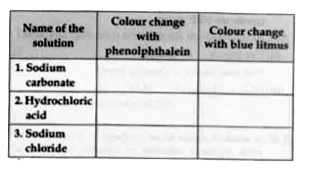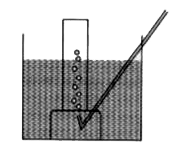Complete Solutions to TOPIC -1 SHORT ANSWER TYPE QUESTIONS -II of chapter ACIDS,BASES AND SALTS of Class 10 book with complete answers and questions
| Class 10 | CHEMISTRY |
| Chapter | ACIDS,BASES AND SALTS |
| OSWAAL PUBLICATION | TOPIC -1 SHORT ANSWER TYPE QUESTIONS -II |
| Number Of Questions | 17 |
| Academic Year | 2023-24 |
(a) What is the action of litmus on:
(i) Dry ammonia gas
(ii) Solution of ammonia gas in water
(b) State the observations you would make on adding sodium hydroxide to aqueous solution of :
(i) Ferrous sulphate
(ii) Aluminium chloride
Give balanced chemical equations.05:52View SolutionDifferentiate between strong and weak acids. Identify the strong and weak acids from the following list of acids: Hydrochloric acid, acetic acid, formic acid, nitric acid.
03:54View Solution(i) Write the name given to bases that are highly soluble in water. Give an example.
(ii) How is tooth decay related to pH? How can it be prevented?
(iii) Why does bee-sting cause pain and irritation? Rubbing of baking soda on the sting area gives relief. How?04:08View Solution(i) Two solutions X and Y are tested with universal indicator. Solutions X turns orange whereas solution Y turns red. Which of the solutions is a stronger acid?
(ii) State the meaning of strong acids and weak acids. Give one example of each.04:43View SolutionName the acid present in the following:
(i) Tomato (ii) Vinegar (iii) Tamarind01:23View SolutionA liquid has a pH less than 7 which represent an acidic solution:
(i) State the nature of solution, if its pH increases from 7 to 14.
(ii) Mention the ion whose concentration increases with the increase in pH value.
(iii) Suggest a method that is generally used for measuring the pH value.03:32View Solution(i) Giving reason for each. State which of the following will conduct electricity and which will not?
(a) A solution of glucose
(b) Dil. Hydrochloric acid
(iii) If acetic acid and hydrochloric acid of same concentration are taken, which of the two is a stronger acid and why?
(iii) How is the strength of an acid affected when some water is added to it?04:08View SolutionTo the three solutions listed below, a few drops of phenophthalein and blue litmus were added separately. Specify the colour change in each case, if any:
 03:04View Solution
03:04View Solution10ml of water and 5ml of sulphuric acid are to be mixed in a beaker.
(i) State the method that should be followed.
(ii) Why should this method be followed.
(iii) What is this process called?02:43View SolutionIllustrate any three chemical properties of acids with examples.
03:39View SolutionSugandha prepares HCl gas in her school laboratory using certain chemicals, She puts both dry and wet blue litmus paper in contact with the gas.
(i) Name the reagents used by Sugandha to prepare HCl gas.
(ii) State the colour changes observed with the dry and wet blue litmus paper.
Show the formation of ions when HCl gas combines with water.03:13View SolutionA student takes three beakers A,B and C filled with aqueous solution of glucose, alcohol and hydrochloric acid respectively as shown in the following figure.

(i) State your observations in terms of glowing of bulb when the switch is on.
(ii) Justify your observations by giving reason in each case.
(iii) Mention the change noticed with appropriate reason if the content of beaker B is replaced by sodium hydroxide solution.View SolutionA metal is treated with dilute sulphuric acid. The gas evolved is collected by the method shown in the figure:

(i) Name the gas
(ii) Is the gas soluble or insoluble in water?
(iii) Is the gas lighter or heavier than air?
(iv) How will you test the gas
(v) IF the metal used above in zinc then write the chemical equation for the evolution of gas
(vi) Write one industrial use of the gas evolved.04:00View SolutionExplain the action of dilute hydrochloric acid on the following with chemical equation.
(a) Magnesium ribbon (b) Sodium hydroxide
(c ) Crushed egg shells03:20View SolutionA few crystals of copper sulphate are heated in B/F dry boiling tube:
(i) What is the colour before and after heating?
(ii) What is the reason for the colour change?
(iii) Can its original colour be restored? How?03:31View Solutionwhile eating food, you spill some curry on your shirt. You immediately scrub with soap, what happens to its yellow colour on scrubbing with soap ? What happens to the stain when the shirt is washed with plenty of water ?
03:31View SolutionAfter drinking excess of cold drink, a person suffers from acidity. Explain.
04:52View Solution
TOPIC -1 SHORT ANSWER TYPE QUESTIONS -II questions and complete solutions for chapter ACIDS,BASES AND SALTS of OSWAAL CHEMISTRY (KANNADA ENGLISH) of Class 10
All Exercises from OSWAAL PUBLICATION Class 10 CHEMISTRY ACIDS,BASES AND SALTS
- NCERT CORNER INTEXT QUESTIONS
- NCERT CORNER TEXTBOOK EXERCISES
- TOPIC -1 MATCH THE COLUMN
- TOPIC -1 SHORT ANSWER TYPE QUESTIONS
- TOPIC -1 SHORT ANSWER TYPE QUESTIONS -II
- TOPIC -1 VERY SHORT ANSWER QUESTION
- TOPIC-1 LONG ANSWER TYPE QUESTIONS
- TOPIC-1 MCQ
- TOPIC-2 LONG ANSWER TYPE QUESTIONS
- Topic-2 MCQ
- Topic-2 SHORT ANSWER TYPE QUESTION -II
- TOPIC-2 SHORT ANSWER TYPE QUESTION-I
- Topic-2 Very Short Answer Type Questions
